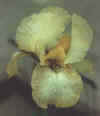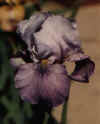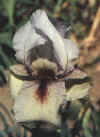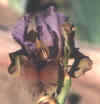Breeding Quarterbreds |
|
Quarterbreds provide a significant opportunity for the beginning hybridizer, a way to get off to a fast start by taking advantage of the TB varieties that most arilbred growers already have in their gardens. Quarterbreds are more like their TB ancestors than their aril ancestors in both appearance and growth habits and in most climates retain their reputation of being the easiest arilbreds to grow. They make excellent garden subjects and, because of their relatively late bloom season, they have a better chance of making it to the show bench. The mechanics are easy, because it's primarily a one-generation-at-a-time program with no need to learn the intricacies of line-breeding and out-crossing. This produces a reasonable, but not excessive, number of seedlings. I've found quarterbreds to be among the easiest to select because most are, without question, destined for the compost heap. This means that the good ones tend to be relatively easy to spot – the cross that produces more than one relatively good seedling is the exception, not the rule. They remain a worthwhile challenge for established hybridizers as well, though, because the long-held goal of aril flowers on TB plants still hasn't been reached. |
|
|
Producing Conventional Quarterbreds |
|
The traditional method of crossing halfbreds with TBs to produce new first-generation quarterbreds is an excellent project for beginners because the main requirement is just the ability to grow both types. While a relatively large available gene pool is an advantage, in my experiments I've found that the pattern of the TB parent seems to be more important than that of the arilbred parent. I've had the greatest success in getting aril traits to show through by using plicatas (especially those with pink ground), bicolors, bicolor plicatas, and anthocyanidin recessives. For examples, see the AABB-BBBB Photo Gallery page. |

Fine Feathered Friend |
|
|
|
Getting Quarterbreds from Near-Arils |
|
A slightly more challenging approach involves crossing near-arils of proven fertility onto TBs. I've done this with both triploid and unbalanced tetraploid varieties, using the TB as the pod parent because of its later bloom season. These seem to maintain the conventional quarterbred-type of plant, yet often have more aril traits in the flower. I'm not suggesting that this is easy. The challenge is in finding a near-aril with enough fertility to be of use. Tribe of Judah has been my most prolific parent, giving me some striking offspring when crossed onto a variety of TBs. For examples, see the AAB-BBBB Photo Gallery page. |

Sostenique X Tribe of Judah Seedling |
|
|
|
|
Using Quarterbreds to Produce more Quarterbre |
|
Another way to obtain arilbreds that qualify as "quarterbreds" by ASI standards is by crossing conventional quarterbreds back to halfbreds. Under the quantum system, the resulting seedlings would have been termed "3/8-breds". In reality, the offspring tend to be like one of the parents, rather than an intermediate type. Some are infertile quarterbreds and some are fully functional halfbreds, but there's no way to know which type a given seedling is without testing it. This is also a difficult cross to make because of the relative infertility of the conventional quarterbreds. MOHRIC ART is a classic example, and I plan to prepare a page devoted to it. JOINT VENTURE is the classic quarterbred I've found most useful in this line, and its basic page is already online. |

Mohric Art Joint Venture |
Return to Quarterbreds
Bibliographies | History | Hybridizing | List of Cultivars | Photo Gallery
